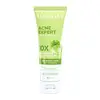What's inside
What's inside
 Key Ingredients
Key Ingredients

 Benefits
Benefits

 Concerns
Concerns

 Ingredients Side-by-side
Ingredients Side-by-side

Water
Skin ConditioningCocamide DEA
EmulsifyingSodium Laureth Sulfate
CleansingCocamidopropyl Betaine
CleansingGlycerin
HumectantSodium Chloride
MaskingSalicylic Acid
MaskingPhenoxyethanol
PreservativePEG-50 Hydrogenated Castor Oil
EmulsifyingPanthenol
Skin ConditioningChlorphenesin
AntimicrobialNelumbo Nucifera Leaf Extract
Skin ConditioningCamellia Sinensis Leaf Extract
AntimicrobialPsidium Guajava Fruit Extract
AstringentAngelica Gigas Extract
Skin ConditioningPropanediol
SolventCitric Acid
BufferingButylene Glycol
HumectantTetrasodium EDTA
Aloe Barbadensis Leaf Extract
EmollientBioflavonoids
Skin ConditioningBrassica Oleracea Italica Extract
AstringentWater, Cocamide DEA, Sodium Laureth Sulfate, Cocamidopropyl Betaine, Glycerin, Sodium Chloride, Salicylic Acid, Phenoxyethanol, PEG-50 Hydrogenated Castor Oil, Panthenol, Chlorphenesin, Nelumbo Nucifera Leaf Extract, Camellia Sinensis Leaf Extract, Psidium Guajava Fruit Extract, Angelica Gigas Extract, Propanediol, Citric Acid, Butylene Glycol, Tetrasodium EDTA, Aloe Barbadensis Leaf Extract, Bioflavonoids, Brassica Oleracea Italica Extract
Water
Skin ConditioningGlycerin
HumectantSodium Cocoyl Glycinate
CleansingDisodium Cocoyl Glutamate
CleansingButylene Glycol
HumectantBetaine
HumectantLauramidopropyl Betaine
CleansingHydroxypropyl Starch Phosphate
Niacinamide
SmoothingCitric Acid
BufferingSodium Chloride
MaskingTocopheryl Acetate
AntioxidantZinc PCA
HumectantCentella Asiatica Extract
CleansingPEG-6 Almond Glycerides
EmollientPropylene Glycol
HumectantCaprylyl Glycol
EmollientAllantoin
Skin ConditioningPanthenol
Skin ConditioningDisodium EDTA
Melaleuca Alternifolia Leaf Oil
AntioxidantPEG-20
HumectantEthylhexylglycerin
Skin ConditioningCaprylic/Capric Triglyceride
MaskingAscorbic Acid
AntioxidantCarbomer
Emulsion StabilisingNordihydroguaiaretic Acid
AntioxidantOleanolic Acid
Skin ConditioningWater, Glycerin, Sodium Cocoyl Glycinate, Disodium Cocoyl Glutamate, Butylene Glycol, Betaine, Lauramidopropyl Betaine, Hydroxypropyl Starch Phosphate, Niacinamide, Citric Acid, Sodium Chloride, Tocopheryl Acetate, Zinc PCA, Centella Asiatica Extract, PEG-6 Almond Glycerides, Propylene Glycol, Caprylyl Glycol, Allantoin, Panthenol, Disodium EDTA, Melaleuca Alternifolia Leaf Oil, PEG-20, Ethylhexylglycerin, Caprylic/Capric Triglyceride, Ascorbic Acid, Carbomer, Nordihydroguaiaretic Acid, Oleanolic Acid
Ingredients Explained
These ingredients are found in both products.
Ingredients higher up in an ingredient list are typically present in a larger amount.
Butylene Glycol (or BG) is used within cosmetic products for a few different reasons:
Overall, Butylene Glycol is a safe and well-rounded ingredient that works well with other ingredients.
Though this ingredient works well with most skin types, some people with sensitive skin may experience a reaction such as allergic rashes, closed comedones, or itchiness.
Learn more about Butylene GlycolCitric Acid is an alpha hydroxy acid (AHA) naturally found in citrus fruits like oranges, lemons, and limes.
Like other AHAs, citric acid can exfoliate skin by breaking down the bonds that hold dead skin cells together. This helps reveal smoother and brighter skin underneath.
However, this exfoliating effect only happens at high concentrations (20%) which can be hard to find in cosmetic products.
Due to this, citric acid is usually included in small amounts as a pH adjuster. This helps keep products slightly more acidic and compatible with skin's natural pH.
In skincare formulas, citric acid can:
While it can provide some skin benefits, research shows lactic acid and glycolic acid are generally more effective and less irritating exfoliants.
Most citric acid used in skincare today is made by fermenting sugars (usually from molasses). This synthetic version is identical to the natural citrus form but easier to stabilize and use in formulations.
Read more about some other popular AHA's here:
Learn more about Citric AcidGlycerin is already naturally found in your skin. It helps moisturize and protect your skin.
A study from 2016 found glycerin to be more effective as a humectant than AHAs and hyaluronic acid.
As a humectant, it helps the skin stay hydrated by pulling moisture to your skin. The low molecular weight of glycerin allows it to pull moisture into the deeper layers of your skin.
Hydrated skin improves your skin barrier; Your skin barrier helps protect against irritants and bacteria.
Glycerin has also been found to have antimicrobial and antiviral properties. Due to these properties, glycerin is often used in wound and burn treatments.
In cosmetics, glycerin is usually derived from plants such as soybean or palm. However, it can also be sourced from animals, such as tallow or animal fat.
This ingredient is organic, colorless, odorless, and non-toxic.
Glycerin is the name for this ingredient in American English. British English uses Glycerol/Glycerine.
Learn more about GlycerinPanthenol is a common ingredient that helps hydrate and soothe the skin. It is found naturally in our skin and hair.
There are two forms of panthenol: D and L.
D-panthenol is also known as dexpanthenol. Most cosmetics use dexpanthenol or a mixture of D and L-panthenol.
Panthenol is famous due to its ability to go deeper into the skin's layers. Using this ingredient has numerous pros (and no cons):
Like hyaluronic acid, panthenol is a humectant. Humectants are able to bind and hold large amounts of water to keep skin hydrated.
This ingredient works well for wound healing. It works by increasing tissue in the wound and helps close open wounds.
Once oxidized, panthenol converts to pantothenic acid. Panthothenic acid is found in all living cells.
This ingredient is also referred to as pro-vitamin B5.
Learn more about PanthenolChances are, you eat sodium chloride every day. Sodium Chloride is also known as table salt.
This ingredient has many purposes in skincare: thickener, emulsifier, and exfoliator.
You'll most likely find this ingredient in cleansers where it is used to create a gel-like texture. As an emulsifier, it also prevents ingredients from separating.
There is much debate on whether this ingredient is comedogenic. The short answer - comedogenic ratings don't tell the whole story. Learn more about comegodenic ratings here.
The concensus about this ingredient causing acne seems to be divided. Research is needed to understand if this ingredient does cause acne.
Scrubs may use salt as the primary exfoliating ingredient.
Learn more about Sodium ChlorideWater. It's the most common cosmetic ingredient of all. You'll usually see it at the top of ingredient lists, meaning that it makes up the largest part of the product.
So why is it so popular? Water most often acts as a solvent - this means that it helps dissolve other ingredients into the formulation.
You'll also recognize water as that liquid we all need to stay alive. If you see this, drink a glass of water. Stay hydrated!
Learn more about Water